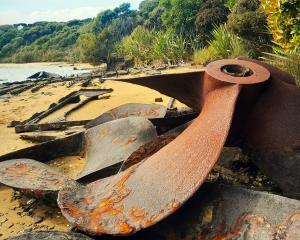A wasp attack on a single person can be deadly. But the invasive pests are also taking a much wider toll, writes Andrew Stone, of the New Zealand Herald.
The memory Janet Kelland retains of a wasp attack is the sensation of being on fire.
''I was burning up,'' recalled Kelland, a Taumarunui sheep farmer.
''They were in my hair, around my eyes, up my legs. The noise was just horrific.''
The 56-year-old was checking a steep fenceline out the back of her property - an area she calls Snake Gully - when she trod in a wasp nest. The disturbed wasps attacked her, and persisted as she tried desperately to brush them off. Relief came only when she jumped into a stock pond.
Six months on, Kelland says her face and scalp and arms have healed but scars remain on her back, where the insects stung through her shirt. Any wasp that gets near her is swiftly rubbed out. She says flies sound louder to her now, which she feels is a legacy of the wasp swarm.
''I was lucky. I knew I was in [trouble] but my throat didn't swell so I could breathe,'' she remarked.
''When the [emergency] helicopter arrived they pumped me full of drugs and threw cold towels on me. But the pain was unbelievable.''
Kelland was attacked in March, a time of intense activity for the highly social insects.
In spring, egg-laying queen wasps that have survived winter search for new nest sites. Scientists have found queens can travel up to 70km to establish a nest, which can contain up to 13,000 worker wasps.
New Zealand has proved a happy hunting ground for invasive wasps, which thrive in the absence of natural predators. Such is the persistence and abundance of wasps that policymakers are investigating the costs the pests impose and devising novel ways to destroy them.
A Ministry of Primary Industries and Department of Conservation study to be published next year will show that wasps cost the economy tens of millions of dollars.
The work - a measure of the pain the insects cause - is for the Wasp Tactical Group, which comprises scientists, government agencies, pest control experts and regional bodies. The group is preparing a strategy to fight the wasp menace.
Prof Phil Lester, of Victoria University, who studies the effect of pathogens on wasps, says the pests are too firmly established to eradicate. But he thinks control is possible with toxic baits, biological control, parasites and pathogens.
Cutting-edge science is involved, and early work on an insect growth regulator (IGR) is showing promise. IGRs stop insects maturing to a reproductive stage, so could stop a wasp colony in its tracks. The challenge is to devise foolproof ways to get wasps to cart what amounts to their death sentence into their home.
Scientists involved with the work say it is too early to discuss it publicly but they are encouraged by progress.
But, as with all wasp research, the aim is to kill invasive wasps and spare other vital insects, such as bees.
Wasps have become New Zealand's most damaging invertebrate pest. They hurt the honey industry by attacking hives, displace bees from honeydew beech forests, disrupt vineyard pollination, imperil logging work in forests and compete with native birds and animals for food.
They have also been observed killing chicks. Between 2010 and last year, ACC dealt with 4160 claims arising from wasp attacks, with costs of $330,000.
The last person to die from a wasp attack was Maurice Robert Stretch (62) who had a heart attack after being stung hundreds of times in the Marlborough Sounds in 2012.
University of Auckland Associate Prof Jacqueline Beggs, who has been studying wasps since 1991, said the pests were insidious, pernicious and likely to get a whole lot worse with the spread of giant willow aphids, an insect first reported last December. The aphids produce honeydew, which wasps find irresistible as a carbohydrate food source.
''If the aphids become abundant, as it looks like they will, I think we're going to see areas of New Zealand that will have a wasp problem they didn't have before.''
THE PROBLEM
When Captain James Cook came ashore in 1769, he was assailed by deafening birdsong. Anyone who has been in the Nelson Lakes National Park beech forests knows the drone of invasive wasps has drowned out the chatter of native birds.
Wasp densities in that dramatic landscape are higher than anywhere else on Earth. Research indicates the weight of wasps in these forests is as much as, or more than, birds, rodents and stoats combined.
Honeydew-feeding kaka struggle to get a look in, and the sheer number of wasps can even alter forest-floor structure by reducing nutrients available for decomposition.
The 1080 pest control approach - where poison is dumped from the air - is out of bounds for wasp control because it would kill too many other insects.
Bait stations, containing wasp-specific toxins mixed with meat, have limited value because wasp numbers are so high and nests proliferate in difficult country.
THE SOLUTION
One trick, says ecologist Ronny Groenteman, is to unite wasps with their natural enemies.
Dr Groenteman, a Landcare Research scientist, is working on making biological control more effective while ensuring non-target species are not harmed.
A tiny mite looks one of the best bets, as it appears to be confined to wasps.
''I suspect if it was damaging to bees we would have known by now but, nonetheless, we don't want to do anything to increase the densities of the mite if it could be damaging to either honey bees, bumblebees or native bees,'' Dr Groenteman said.
''If we discover any of these groups could be at risk from the mite, we will abandon it as a biocontrol solution.''
Dr Bob Brown, who found the mite by accident during his doctoral research, said it was not yet known whether the mites were destroying wasp nests or carting a pathogen into the colonies.
At Lincoln, near Christchurch, Plant and Food Research scientist Ashraf El-Sayed is working on a superlure specific to wasps, a combination of compounds derived from mussels and honeydew.
Beech forest trials using the lure and a poison took a heavy toll. The approach held promise where traps could be laid, but different methods were needed in hard-to-reach places.
Dr El-Sayed said a pheromone or chemical message from queens identified during his research had the potential to disrupt wasp behaviour, but needed more work.
Ecologist Jacqueline Beggs thinks wasp control will need a pile of weapons.
''We're dealing with a colonial animal and they've got so many strategies to ensure the survival of the colony. While it feels good to put out traps and see them fill up with worker wasps, it does diddly squat to control the population because the queen is safe in the nest and able to up her production and pump out heaps more.
''So some of the standard control techniques are not so effective for a social insect.''
Dr Beggs says using the wasp's own biology to get a toxin into the colony was perhaps the most promising, because workers would seal their fate with the queen.
''Then it's game over,'' she said.
''With wasps, we've had this issue that they're not a top pest problem for any industry. But if you lump it together you see that they're a problem which is getting bigger. We've just got to hope there will be funding around to deal with it.''











